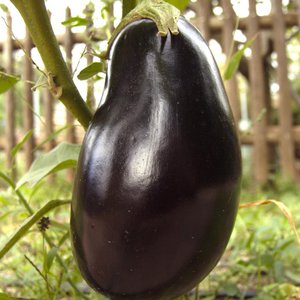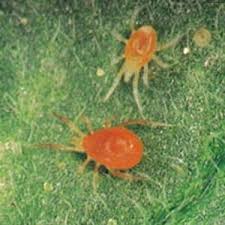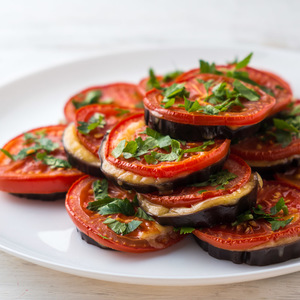Early maturing and thermophilic eggplant "Vera" from domestic breeders
Vera's eggplant is widespread among gardeners in Russia and neighboring countries. This vegetable possesses remarkable taste and external characteristics and contains a lot of elements useful and necessary for the body.
In the article, we will consider what a culture is, we will analyze in detail the characteristics and description of the variety.
The content of the article
Description of the variety
The Vera variety appeared at the end of the 20th century. Eggplant is intended for growing in private gardens and backyard plots. It shows itself perfectly in the Urals, Siberia and the Far Eastern District.
Distinctive features
 The early ripening variety ripens within 100-120 days from the moment of planting. It is grown in the open field or in a greenhouse. To obtain the best harvest, summer residents grow the variety in seedlings. He is unpretentious in leaving, requires a minimum of attention.
The early ripening variety ripens within 100-120 days from the moment of planting. It is grown in the open field or in a greenhouse. To obtain the best harvest, summer residents grow the variety in seedlings. He is unpretentious in leaving, requires a minimum of attention.
Specifications
Bushes are compact, reach 70-75 cm in height. Leaves are medium-sized, green with a purple tint.
Pear-shaped, purple color. The pulp is dense, white, without bitterness.
The length of one fruit is about 20 cm, weight is from 150 to 300 g. From 1 sq. m gardeners collect from 1.5 to 3 kg of vegetables.
Interesting! The ancient Greeks were convinced that eggplants were harmful and even dangerous to health. The purple fruit was called the "apple of madness" and they were convinced that the vegetable took a person's mind.
How to grow this variety yourself
The best vegetables are grown in their own garden. Eggplants are loved by both experienced gardeners and novice gardeners. How to grow the Vera variety tasty and healthy?
Growing seedlings
Seedlings are grown in prepared soil. The land should be clean and nutritious, free of debris and weeds. It is best to take the soil from the garden and disinfect it by placing it in the oven for 1 hour. High temperatures will kill dangerous germs and help avoid future fungi and infections.
In addition to the soil, a container is prepared. Seedlings are grown in any clean and dry container, for example, in plastic cups, flower pots, plastic boxes.
High-quality seeds are selected for planting. The selection is carried out using a jar of water, in which the seeds are placed. Stir the water clockwise. Those seeds that have sunk to the bottom are suitable for seedlings. Next, the seeds are disinfected with Bordeaux liquid and thoroughly dried.
Earth is placed in the container, holes are made at a distance of 10 cm from each other. 2-3 seeds are placed in each, sprinkled with earth on top and watered abundantly.
Seedlings are placed in a warm place. The next watering after planting is carried out in a week. Make sure that the soil does not dry out and is not too wet. After 2 weeks, fertilize the eggplant with liquid bird droppings.
The optimum temperature for seedlings is 20 degrees, air humidity is 80-85%. Eggplants need a lot of light, so gardeners will arrange additional lighting for them with fluorescent lamps.
Transfer
Seedlings are planted in the garden at the end of May... A week before planting, gardeners prepare beds measuring 30 × 100 cm.The earth is well moistened and fresh manure is introduced. Place the sprouts in open ground carefully so as not to damage the still weak roots.
The distance between the bushes should be at least 40 cm. To prevent the plants from freezing, they are covered with a thin film, which is completely removed in mid-late June. After transplanting, the eggplants are watered with settled water.One bush consumes 0.5 liters.
Further care
Eggplant Vera is watered so that the ground is constantly slightly moist. The water is heated in the sun and poured directly under the root. After each watering, the beds are loosened in the aisles. Once a week, instead of ordinary water, use an infusion of nettle or onion peel. Folk remedies not only moisturize the beds, but also have a preventive effect and increase the immunity of the plant.
Eggplants love mineral fertilizers... The first top dressing is applied 15 days after the transplantation of seedlings into open ground. Gardeners use Apion or Kimira products. The preparations improve the palatability of the fruit, increase the yield and protect the plant from pests. In addition to mineral fertilizers, eggplants are fed three times per season with ash, manure or humus.
Important! When using mineral fertilizers, follow the dosage and manufacturer's recommendations. Violation of the rules can lead to the death of plants.
Features of cultivation and possible difficulties
When growing eggplants of the Vera variety, many gardeners are faced with the problem of a lack of boron. With a lack of boron in eggplants, lateral shoots develop intensively, the leaves become pale green and weak. Flowers fall, there is no flowering. Mineral fertilizers, which contain the missing element, help to solve the problem. Summer residents spray eggplant beds with boric acid (1 g of acid is required per 10 liters of water).
In addition to boron, eggplants often require potassium supplements. A sign of potassium deficiency - light spots on the fruit, while the leaves dry out and acquire a yellow tint. It is recommended to feed eggplants with potassium using dry wood ash. It has a positive effect on both the eggplant and the quality and nutritional properties of the soil.
Diseases and pests
Often they live in the beds spider mites. These dangerous little insects settle on leaves, weave their transparent cobwebs, suck nutritious juices from the plant and disrupt metabolism. Ticks appear in the beds due to improper care and contaminated soil.
Spraying with milk whey helps to get rid of them. The method is effective and safe for human health. In addition to the tick, you can find a bear or a wireworm in the beds. Bordeaux liquid or a solution of copper sulfate helps in the fight against them.
Of the diseases, the well-known phytophthora fungus attacks eggplants. Spores of the fungus enter the plant stem through the stomata. Favorable conditions for the spread of spores are hot and humid summers.
In the fight against fungus, gardeners use the drug "Oxyhom" or ash. In addition to late blight, eggplants get sick with mosaics. The virus appears as a yellow pattern on the leaves. "Fitosporin" is used against the mosaic.
Harvesting and application of the crop
 The Vera variety is harvested at the end of August. It is not advisable to overexpose the fruits in the garden, since over time they lose their elasticity, and the pulp will acquire bitterness and wateriness.
The Vera variety is harvested at the end of August. It is not advisable to overexpose the fruits in the garden, since over time they lose their elasticity, and the pulp will acquire bitterness and wateriness.
The fruits are carefully cut along with the stalk, wiped with a dry cloth and put into wooden boxes. It is not recommended to store eggplants for a long time; it is better to process them within one month from the date of collection.
Eggplants make delicious and healthy hot snacks, vegetable salads and side dishes. Eggplants are stuffed with meat or poultry - such a dish will adorn any festive table.
Due to its low calorie content, the vegetable is suitable for those who follow the figure and adhere to a proper diet. Eggplant makes an excellent puree soup and a harmless pate or caviar.
Interesting! Doctors recommend using eggplant for those who want to quit smoking. The fact is that the vegetable contains nicotinic acid.
Housewives use the product for cosmetic purposes. For example, they make nourishing and rejuvenating face masks. The eggplant pulp is chopped on a grater, applied to the face for 20 minutes.The procedure moisturizes the skin and stimulates metabolic processes. In addition, eggplant rings are applied to the eyelids to reduce puffiness.
Advantages and disadvantages of the variety
The Vera variety is ideal for gardeners from regions with unpredictable climatic conditions. An early-ripening vegetable will not keep you waiting long and will delight you with the first harvest in 2.5 months.
The commercial qualities of the variety are excellent, the purple glossy color looks appetizing and attractive. Taste without bitterness, pleasant. The vegetable is versatile, combined with fish, meat and other vegetables. Suitable for canning and pickling.
The variety has only one drawback: it shows an average yield. Many other early ripening varieties have a richer harvest.
Read also:
Do I need to peel eggplants and how to do it correctly.
Review of the nutcracker eggplant variety: advantages and disadvantages.
A relatively new, but managed to fall in love with summer residents, the Almaz eggplant variety.
Reviews of gardeners
Gardeners' forums are full of reviews about the popular and tasty Vera variety. What do experienced gardeners say about vegetables?
Nikita, Chelyabinsk: “I love eggplants because of their unpretentious care and useful composition. Of all the varieties, Vera I like more than others. Eggplant has a bizarre shape and delicious pulp. I use the vegetable both for cooking and for preserving. "
Maria, Sochi: “Vera has planted an eggplant for the first time. I was pleased with the harvest. The return is friendly, all the fruits are smooth and glossy. As a raw food eater, I eat fruits only fresh. The taste is pleasant, does not taste bitter. "
Alexandra, Moscow: “Vera planted the eggplants with seeds in the open ground. Perhaps this is why the harvest was poor. Although the fruits are tasty, there are very few of them. I will not plant any more varieties. "
Conclusion
The purple color and interesting taste of the eggplant Vera attracts the attention of many summer residents. It is easy to grow a variety, the main thing is to observe the regime of watering and feeding. Please note that harvesting is recommended on time.
A later harvest will only harm your health, as the vegetables will become lethargic and tasteless. Eggplants make excellent dishes: caviar, salads, canned food and even sweet and savory snacks.